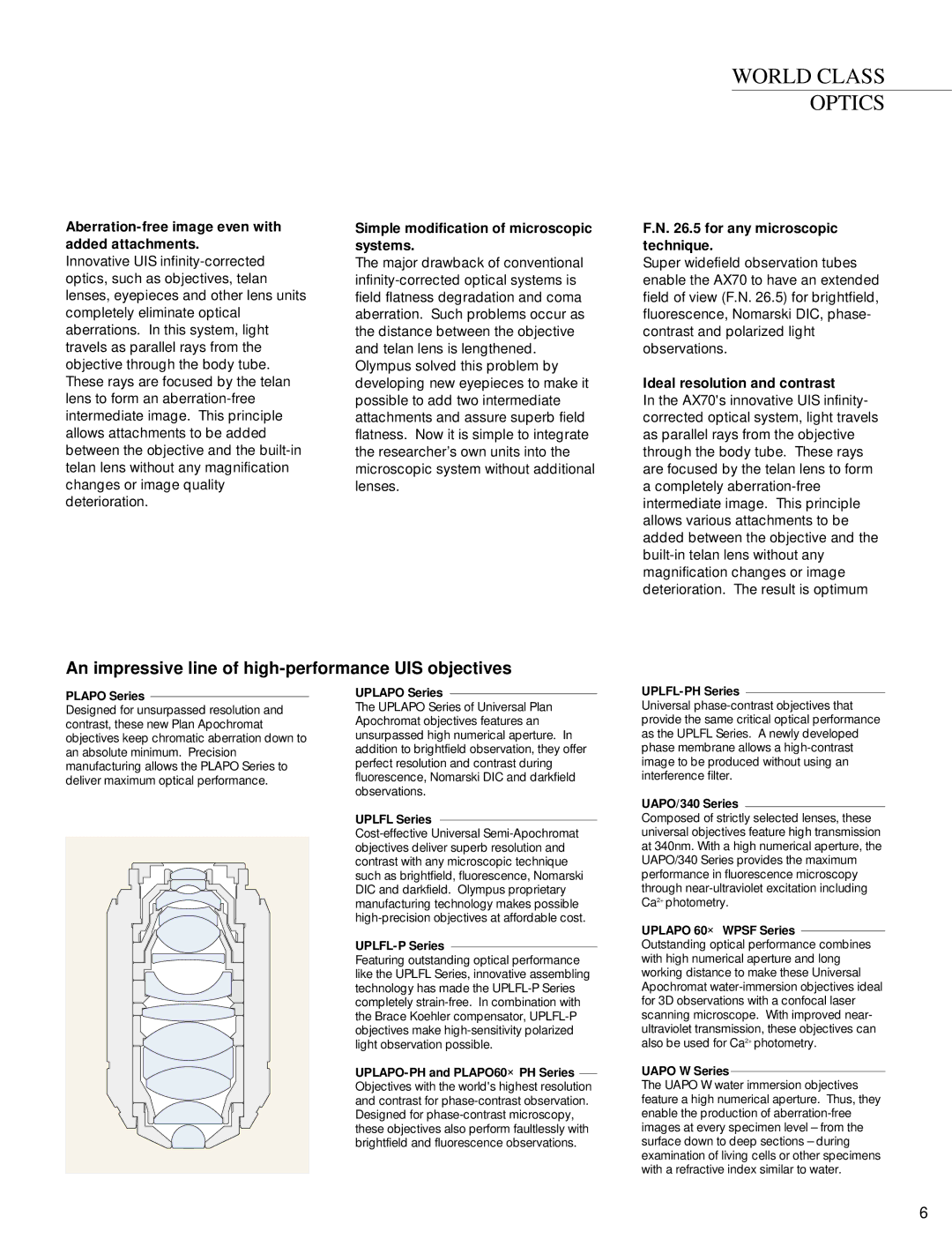Aberration-free image even with added attachments.
Innovative UIS infinity-corrected optics, such as objectives, telan lenses, eyepieces and other lens units completely eliminate optical aberrations. In this system, light travels as parallel rays from the objective through the body tube. These rays are focused by the telan lens to form an aberration-free intermediate image. This principle allows attachments to be added between the objective and the built-in telan lens without any magnification changes or image quality deterioration.
Simple modification of microscopic systems.
The major drawback of conventional infinity-corrected optical systems is field flatness degradation and coma aberration. Such problems occur as the distance between the objective and telan lens is lengthened. Olympus solved this problem by developing new eyepieces to make it possible to add two intermediate attachments and assure superb field flatness. Now it is simple to integrate the researcher’s own units into the microscopic system without additional lenses.
F.N. 26.5 for any microscopic technique.
Super widefield observation tubes enable the AX70 to have an extended field of view (F.N. 26.5) for brightfield, fluorescence, Nomarski DIC, phase- contrast and polarized light observations.
Ideal resolution and contrast
In the AX70's innovative UIS infinity- corrected optical system, light travels as parallel rays from the objective through the body tube. These rays are focused by the telan lens to form a completely aberration-free intermediate image. This principle allows various attachments to be added between the objective and the built-in telan lens without any magnification changes or image deterioration. The result is optimum
PLAPO Series
Designed for unsurpassed resolution and contrast, these new Plan Apochromat objectives keep chromatic aberration down to an absolute minimum. Precision manufacturing allows the PLAPO Series to deliver maximum optical performance.
UPLAPO Series
The UPLAPO Series of Universal Plan Apochromat objectives features an unsurpassed high numerical aperture. In addition to brightfield observation, they offer perfect resolution and contrast during fluorescence, Nomarski DIC and darkfield observations.
UPLFL Series
Cost-effective Universal Semi-Apochromat objectives deliver superb resolution and contrast with any microscopic technique such as brightfield, fluorescence, Nomarski DIC and darkfield. Olympus proprietary manufacturing technology makes possible high-precision objectives at affordable cost.
UPLFL-P Series
Featuring outstanding optical performance like the UPLFL Series, innovative assembling technology has made the UPLFL-P Series completely strain-free. In combination with the Brace Koehler compensator, UPLFL-P objectives make high-sensitivity polarized light observation possible.
UPLAPO-PH and PLAPO60×PH Series Objectives with the world's highest resolution and contrast for phase-contrast observation. Designed for phase-contrast microscopy, these objectives also perform faultlessly with brightfield and fluorescence observations.
UPLFL-PH Series
Universal phase-contrast objectives that provide the same critical optical performance as the UPLFL Series. A newly developed phase membrane allows a high-contrast image to be produced without using an interference filter.
UAPO/340 Series
Composed of strictly selected lenses, these universal objectives feature high transmission at 340nm. With a high numerical aperture, the UAPO/340 Series provides the maximum performance in fluorescence microscopy through near-ultraviolet excitation including Ca2+ photometry.
UPLAPO 60× WPSF Series
Outstanding optical performance combines with high numerical aperture and long working distance to make these Universal Apochromat water-immersion objectives ideal for 3D observations with a confocal laser scanning microscope. With improved near- ultraviolet transmission, these objectives can also be used for Ca2+ photometry.
UAPO W Series
The UAPO W water immersion objectives feature a high numerical aperture. Thus, they enable the production of aberration-free images at every specimen level – from the surface down to deep sections – during examination of living cells or other specimens with a refractive index similar to water.

